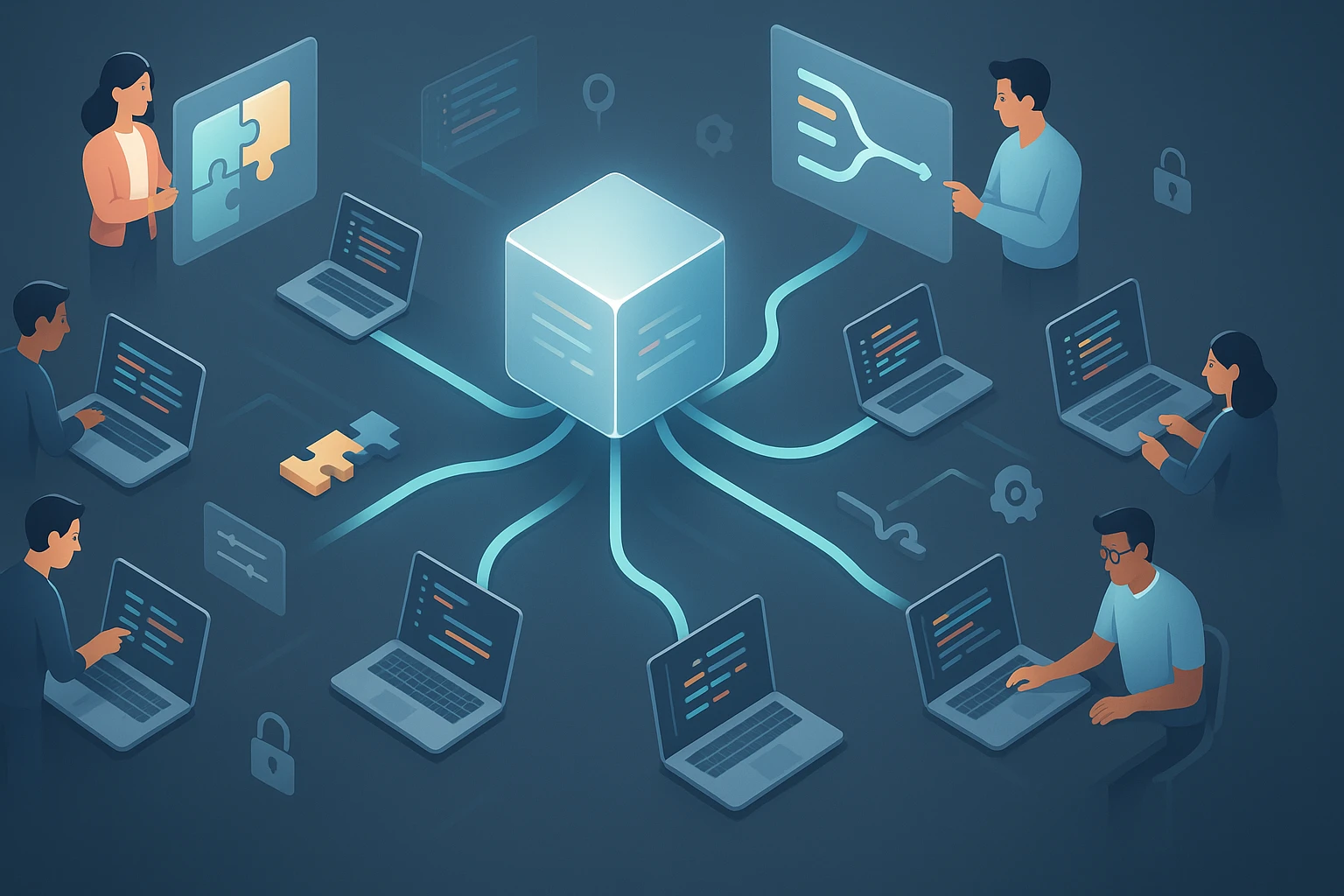Code Comments: When to Use and When to Avoid
Illustration showing a developer deciding when to add code comments: best practices, examples to use comments, avoid pitfalls, checklist icons for clarity, redundancy, maintenance.

Sponsor message — This article is made possible by Dargslan.com, a publisher of practical, no-fluff IT & developer workbooks.
Why Dargslan.com?
If you prefer doing over endless theory, Dargslan’s titles are built for you. Every workbook focuses on skills you can apply the same day—server hardening, Linux one-liners, PowerShell for admins, Python automation, cloud basics, and more.
Code Comments: When to Use and When to Avoid
Every developer has faced the dilemma: should I add a comment here, or is the code clear enough on its own? This seemingly simple question has sparked countless debates in development teams, code reviews, and programming communities worldwide. The way we document our code directly impacts not just our own productivity, but the efficiency of entire teams, the maintainability of projects, and ultimately, the success of software products.
Code comments are annotations written in source code to explain what the code does, why certain decisions were made, or how complex algorithms work. Yet the practice of commenting exists on a spectrum—from over-documented codebases drowning in unnecessary explanations to under-documented projects that leave developers struggling to understand basic logic. This article explores both perspectives: when comments become invaluable assets and when they transform into technical debt.
Throughout this exploration, you'll discover practical guidelines for writing meaningful comments, recognize warning signs of comment abuse, learn industry best practices from various programming paradigms, and gain frameworks for making informed decisions about documentation. Whether you're a junior developer learning to document your first project or a senior engineer refining your team's coding standards, these insights will help you strike the right balance between clarity and conciseness.
The Fundamental Purpose Behind Code Comments
Before diving into specific scenarios, understanding why comments exist helps frame the entire discussion. Comments serve as a communication bridge between the code's author and future readers—who might be other developers, or even the original author months later. The human brain processes natural language differently than programming syntax, and sometimes a single sentence in plain English can convey what would take minutes to decipher from code alone.
The primary purpose of comments is to capture intent and context that cannot be expressed through code itself. Programming languages excel at describing how something works, but they often fall short at explaining why a particular approach was chosen, what alternatives were considered, or what business rules are being implemented. This contextual information becomes critical during debugging, refactoring, or feature enhancement.
"The best comment is the one that explains why something exists, not what it does. The code itself should tell you what it does."
Comments also serve as documentation for complex algorithms, mathematical formulas, or domain-specific logic that requires specialized knowledge. When implementing a cryptographic function, a financial calculation, or a scientific algorithm, comments can reference the original papers, explain the mathematical basis, or clarify assumptions that aren't obvious from the code structure alone.
The Evolution of Commenting Practices
Commenting practices have evolved significantly over the decades. In the early days of programming, when code was often written in assembly language or early high-level languages with limited expressiveness, extensive commenting was not just recommended but necessary. Variable names were restricted to a few characters, and the gap between code and human understanding was vast.
Modern programming languages offer much more expressive capabilities. Meaningful variable names, descriptive function names, clear class hierarchies, and design patterns all contribute to self-documenting code. This evolution has shifted the commenting philosophy from "document everything" to "document what matters." The rise of clean code principles, championed by developers and authors across the industry, emphasizes writing code that reads like prose, minimizing the need for explanatory comments.
When Comments Become Essential Assets
Certain situations demand well-crafted comments regardless of how clean your code is. Recognizing these scenarios helps developers invest their documentation efforts where they provide maximum value.
Complex Business Logic and Domain Rules
Business requirements often contain nuances that cannot be captured in variable names or function signatures. When implementing tax calculations, regulatory compliance rules, or industry-specific algorithms, comments that reference the source of these requirements become invaluable. A comment citing a specific regulation, policy document, or business decision provides context that prevents future developers from "fixing" code that appears odd but is actually correct.
// Per IRS Publication 590-B (2023), RMD age changed from 72 to 73
// for individuals who reach 72 after December 31, 2022
// Source: SECURE 2.0 Act, Section 107
const RMD_AGE_THRESHOLD = 73;This type of comment does more than explain—it provides traceability. When regulations change or business rules are questioned, these comments serve as breadcrumbs leading back to the original requirements, saving hours of archaeological code investigation.
Non-Obvious Performance Optimizations
Performance-critical code often requires approaches that sacrifice readability for speed. When you've profiled your code, identified a bottleneck, and implemented an optimization that makes the code less intuitive, a comment explaining this trade-off becomes essential.
"When performance optimization makes code less readable, a comment isn't optional—it's mandatory. Future developers need to know why the obvious approach wasn't used."
These comments should include information about the performance problem that was solved, measurements before and after the optimization, and ideally, a reference to the profiling data or benchmark results. This prevents well-meaning developers from "cleaning up" optimized code back into a slower but more readable form.
Workarounds and Bug Fixes
Every codebase eventually contains workarounds for third-party library bugs, browser quirks, or system limitations. Without documentation, these workarounds look like mistakes waiting to be corrected. A comment explaining the issue, ideally with a link to a bug report or issue tracker, transforms confusing code into documented technical debt.
- Browser compatibility fixes that address specific version bugs
- Third-party library workarounds compensating for known issues
- Platform-specific code handling OS or environment differences
- Temporary solutions awaiting upstream fixes or future refactoring
Public API Documentation
When writing libraries, frameworks, or any code consumed by other developers, comprehensive comments become part of your API contract. Documentation generators like JSDoc, Javadoc, or Python's docstrings rely on structured comments to create API references. These comments should explain parameters, return values, exceptions, usage examples, and any side effects.
| Documentation Element | Purpose | Example Content |
|---|---|---|
| Function Description | Explains what the function does at a high level | "Calculates compound interest over a specified period" |
| Parameter Documentation | Describes expected input types and constraints | "@param principal - Initial investment amount (must be positive)" |
| Return Value | Specifies what the function returns | "@returns The final amount including compound interest" |
| Exceptions | Documents error conditions | "@throws InvalidArgumentError if rate is negative" |
| Usage Examples | Provides practical implementation guidance | "@example calculateCompoundInterest(1000, 0.05, 10)" |
Algorithm Explanations and Mathematical Formulas
When implementing complex algorithms—sorting algorithms, search algorithms, cryptographic functions, or mathematical computations—comments that explain the approach, cite sources, or break down the logic into understandable steps add tremendous value. These comments often include references to academic papers, algorithm descriptions, or mathematical proofs.
For mathematical formulas, comments can include the actual formula in mathematical notation, explain what each variable represents, and clarify any assumptions or constraints. This is particularly important in fields like graphics programming, machine learning, financial modeling, or scientific computing where the connection between code and underlying mathematics isn't always obvious.
When Comments Become Technical Debt
Not all comments add value. Some actively harm code quality, create maintenance burdens, or signal deeper problems with the code itself. Recognizing these anti-patterns helps developers avoid common commenting pitfalls.
Redundant Comments That Restate the Code
The most common commenting mistake is writing comments that simply translate code into English without adding any information. These comments create noise, require maintenance without providing value, and can actually make code harder to read by forcing developers to parse both code and redundant text.
// Bad: Comment adds no information
// Set x to 5
x = 5;
// Increment counter by 1
counter++;
// Good: Comment explains why
// Reset to default page size for mobile viewports
x = 5;If your comment can be derived by simply reading the code, it's adding no value. These comments often emerge from coding standards that mandate "every line must have a comment" without considering whether those comments serve a purpose.
Outdated Comments Creating Confusion
Comments become liabilities when they fall out of sync with the code they describe. As code evolves through bug fixes, refactoring, and feature additions, comments often get left behind. An outdated comment is worse than no comment at all because it actively misleads developers, creating confusion and potentially introducing bugs.
"An outdated comment is a lie that lives in your codebase. It's more dangerous than no comment because developers trust documentation."
This problem compounds in teams without strong code review practices. When developers update code but forget to update associated comments, the documentation becomes fiction. The only solution is treating comments as code—they must be reviewed, updated, and validated with the same rigor as the logic they describe.
Comments Explaining Bad Code
When you find yourself writing a lengthy comment to explain confusing code, that's often a signal that the code itself needs improvement. Comments should complement good code, not compensate for poor code. If code requires extensive explanation, consider whether refactoring—extracting methods, renaming variables, simplifying logic—might eliminate the need for the comment entirely.
- 🔍 Complex conditional statements that need paragraph-long explanations might benefit from extraction into well-named functions
- 🔍 Cryptic variable names requiring comments to explain their purpose should simply be renamed
- 🔍 Long functions needing section comments might need to be split into smaller, focused functions
- 🔍 Unclear logic flow requiring step-by-step comments might indicate poor code structure
- 🔍 Magic numbers explained in comments should become named constants
Commented-Out Code
Leaving commented-out code in the codebase is almost always a mistake. Version control systems exist precisely to preserve code history—there's no need to keep old code as comments "just in case." Commented-out code creates confusion about whether it's meant to be used, creates clutter, and suggests uncertainty about the current implementation.
The only exception might be during active development when temporarily commenting code for debugging purposes, but even then, this commented code should never make it into the main branch. If code might be useful later, document why it was removed in the commit message where it's deleted.
Apology Comments and Blame
Comments like "this is a hack," "sorry about this mess," or "I don't know why this works" indicate problems that should be addressed rather than documented. These comments acknowledge technical debt without resolving it. Instead of apologizing in comments, either fix the problem or create a proper task in your issue tracker to address it later, with a comment linking to that task.
"Never apologize in comments. Either fix the code or create a ticket to fix it later. Apologies don't improve codebases."
Best Practices for Effective Commenting
When you do write comments, following established best practices ensures they add maximum value with minimum maintenance burden.
Write Comments for Your Future Self
Assume you'll return to this code in six months with no memory of the implementation details or context. What information would you wish you had documented? This perspective helps identify truly valuable comments while avoiding obvious explanations.
Consider the questions future readers might have: Why was this approach chosen? What alternatives were considered? What assumptions is this code making? What external dependencies or requirements drove this implementation? Answering these questions in comments provides lasting value.
Focus on the Why, Not the What
Code already tells readers what it does. Comments should explain why it does it that way. This shift in focus eliminates most redundant comments while highlighting the valuable ones. When reviewing your comments, ask: "Does this explain something that cannot be determined from reading the code?"
| Comment Focus | Value | Example |
|---|---|---|
| What the code does | Low - redundant with code | "Loop through all users" |
| How it works | Medium - useful for complex logic | "Uses binary search for O(log n) performance" |
| Why this approach | High - provides context | "Linear search used because dataset is typically under 10 items" |
| Business context | High - connects code to requirements | "Premium users get priority per product spec v2.3" |
| Historical context | High - prevents repeated mistakes | "Previous async implementation caused race conditions in production" |
Keep Comments Close to the Code They Describe
Comments separated from their related code quickly become orphaned and outdated. Place comments immediately before or within the code they explain. This proximity makes it more likely that developers will update comments when they modify the code, and it makes the relationship between comment and code obvious.
Use Consistent Formatting and Style
Establish team conventions for comment formatting. Consistent style makes comments easier to scan and helps distinguish different types of comments. Many teams use specific tags like TODO, FIXME, HACK, or NOTE to categorize comments and make them searchable.
// TODO: Optimize this query when user base exceeds 10k
// FIXME: Race condition possible under heavy load
// HACK: Workaround for IE11 bug #12345
// NOTE: This assumes UTC timezoneReview Comments During Code Reviews
Treat comments as first-class citizens during code review. Review them for accuracy, clarity, and value just as you would the code itself. Question comments that seem unnecessary, ask for clarification on comments that are unclear, and ensure comments stay synchronized with code changes.
"Code reviews should scrutinize comments as carefully as code. A misleading comment can cause more damage than a small bug."
Language-Specific Considerations
Different programming languages and ecosystems have established their own commenting conventions and tools. Understanding these language-specific practices helps you follow community standards and leverage available tooling.
Statically Typed vs. Dynamically Typed Languages
In statically typed languages like Java, C#, or TypeScript, type information is explicit in the code, reducing the need for comments explaining parameter types or return values. Documentation generators can extract this information automatically. In dynamically typed languages like Python, JavaScript, or Ruby, comments often need to specify expected types, especially for public APIs.
However, this doesn't mean statically typed languages need fewer comments overall. They still require comments explaining business logic, algorithms, and design decisions. The type system handles what types are involved, but comments still need to explain why those types were chosen or how they're used.
Documentation Generation Tools
Most modern languages have documentation generation tools that parse structured comments to create API documentation. JSDoc for JavaScript, Javadoc for Java, Doxygen for C++, RDoc for Ruby, and Sphinx for Python all rely on specific comment formats. When working in these ecosystems, following the conventional comment structure enables automatic documentation generation.
These tools typically support rich formatting, code examples, cross-references, and even type checking in some cases. Investing time in learning your language's documentation conventions pays dividends in automatically generated, always-current API documentation.
Team Dynamics and Comment Culture
Commenting practices don't exist in a vacuum—they're shaped by team culture, project requirements, and organizational standards. Establishing healthy commenting practices at the team level requires explicit discussion and agreement.
Establishing Team Guidelines
Rather than leaving commenting to individual preference, successful teams establish explicit guidelines. These guidelines should address when comments are required, what types of comments add value, formatting conventions, and how comments are reviewed. Document these standards in your team's style guide or contribution guidelines.
Effective guidelines strike a balance between providing structure and allowing flexibility. They should emphasize principles over rigid rules, helping developers make good judgment calls rather than following prescriptive checklists. Guidelines should evolve based on team experience—what works for a small startup might not work for a large enterprise with regulatory requirements.
Onboarding and Knowledge Transfer
Comments play a crucial role in onboarding new team members. Well-commented code helps newcomers understand not just what the code does, but why it exists and how it fits into the larger system. This is especially valuable for domain-specific logic or historical decisions that aren't obvious from the code structure.
However, comments alone aren't sufficient for knowledge transfer. They should complement other documentation—architecture diagrams, design documents, API references, and runbooks. Comments provide the micro-level context while other documentation provides the macro-level understanding.
The Self-Documenting Code Philosophy
The concept of self-documenting code has gained significant traction in modern software development. This philosophy argues that well-written code should be understandable without comments, through careful naming, clear structure, and appropriate abstraction. Understanding this perspective helps developers write better code and make informed decisions about when comments are truly necessary.
Making Code Readable Without Comments
Self-documenting code relies on several key principles. Meaningful names for variables, functions, and classes convey intent without requiring explanation. A function named calculateMonthlyInterest needs no comment to explain its purpose. Small, focused functions with single responsibilities are easier to understand than large, multi-purpose functions.
Proper use of design patterns and architectural principles creates familiar structures that experienced developers recognize immediately. When code follows established patterns, readers can leverage their existing knowledge rather than deciphering novel approaches. Consistent formatting and style reduces cognitive load, allowing developers to focus on logic rather than syntax.
When Self-Documentation Isn't Enough
Despite its benefits, self-documenting code has limits. It excels at explaining what and how, but struggles with why and context. Business rules, regulatory requirements, performance considerations, and historical decisions often require explicit documentation because they involve information external to the code itself.
"Self-documenting code is an ideal worth pursuing, but it's not a complete replacement for all comments. Some context simply cannot be expressed in code."
The goal isn't choosing between self-documenting code and comments—it's using both appropriately. Write code that minimizes the need for comments, then add comments where they provide information that code cannot express.
Comments in Different Development Phases
Commenting needs vary across different stages of software development. Understanding these variations helps developers adjust their documentation approach based on project maturity and context.
Prototyping and Experimental Code
During rapid prototyping or experimental development, extensive commenting may slow down iteration without providing proportional value. Quick experiments, proof-of-concepts, and throwaway code often benefit from minimal documentation. However, even experimental code should include basic context—what problem is being explored, what approach is being tested, and what the expected outcome is.
The key is recognizing when experimental code transitions to production code. At that point, documentation standards should increase accordingly. Many technical debt issues arise from prototypes that accidentally became production systems without proper documentation.
Production Code and Long-Term Maintenance
Production code requires higher documentation standards. Code that will be maintained for years, potentially by developers who weren't involved in its creation, benefits from comprehensive comments explaining design decisions, business rules, and non-obvious logic. The cost of writing these comments is amortized over the lifetime of the code.
Long-lived codebases also accumulate historical context that becomes increasingly valuable over time. Comments explaining why certain approaches were abandoned, what problems previous implementations encountered, or what constraints shaped current design decisions prevent teams from repeating past mistakes.
Open Source Projects
Open source projects have unique documentation needs. Contributors come from diverse backgrounds, with varying levels of familiarity with the codebase. Comprehensive comments lower the barrier to contribution, helping newcomers understand code structure and make meaningful contributions more quickly.
Open source projects also benefit from comments that explain contribution guidelines, testing approaches, and architectural decisions. These comments serve both as documentation and as teaching tools, helping the community understand not just what the code does but how to extend it properly.
Automated Tools and Comment Analysis
Modern development tools can help maintain comment quality and consistency. Understanding these tools and how to leverage them improves overall code documentation.
Linters and Documentation Checkers
Many linters can enforce commenting standards, flagging missing documentation on public APIs, detecting outdated comments, or ensuring consistent formatting. Tools like ESLint, Pylint, or RuboCop can be configured with rules about required documentation, helping teams maintain standards automatically.
Documentation coverage tools measure what percentage of public APIs have documentation, similar to how code coverage tools measure test coverage. While high documentation coverage doesn't guarantee quality, it ensures that public interfaces at least have basic documentation.
Comment Quality Analysis
Some advanced tools analyze comment quality, detecting redundant comments, identifying potential mismatches between comments and code, or flagging comments that might be outdated. While these tools aren't perfect, they can highlight potential issues for human review.
Natural language processing techniques can identify comments that are too vague, too verbose, or potentially misleading. These tools work best as aids during code review rather than as strict gatekeepers, providing suggestions that human reviewers can evaluate in context.
Cultural and Philosophical Perspectives
The debate over commenting practices reflects deeper philosophical differences about code readability, maintainability, and the role of documentation in software development. Understanding these perspectives helps developers navigate discussions about commenting standards.
The Minimalist Perspective
Some developers advocate for minimal commenting, arguing that comments are often a crutch for poorly written code. This perspective emphasizes that time spent writing comments might be better spent improving code clarity. Proponents argue that comments create maintenance burden and often become outdated, while well-written code remains accurate by definition.
This philosophy has merit—it pushes developers to write clearer code and question whether comments are truly necessary. However, taken to an extreme, it can result in codebases that lack crucial context, making maintenance and onboarding more difficult.
The Documentation-First Perspective
Other developers advocate for comprehensive documentation, arguing that comments are essential for knowledge transfer, onboarding, and long-term maintenance. This perspective emphasizes that code clarity alone cannot capture business context, design decisions, or historical information.
This approach ensures that context is preserved, but can lead to over-documentation if not balanced with judgment about what truly needs explanation. The key is distinguishing between valuable documentation and redundant noise.
Finding Practical Balance
Most successful teams find a middle ground, establishing principles rather than rigid rules. They emphasize writing clear code that minimizes the need for comments while recognizing situations where comments add essential value. This pragmatic approach acknowledges that different code serves different purposes and requires different levels of documentation.
Common Pitfalls and How to Avoid Them
Even experienced developers fall into commenting traps. Recognizing these common mistakes helps avoid them.
Over-Commenting Simple Code
Beginning developers often over-comment, explaining every line. This creates noise and makes code harder to read. The solution is developing confidence in code clarity and trusting that other developers can understand straightforward logic without explanation.
Under-Commenting Complex Logic
Experienced developers sometimes under-comment, assuming that what's obvious to them will be obvious to others. Complex algorithms, business rules, or non-obvious optimizations need explanation regardless of the developer's expertise. The solution is putting yourself in the shoes of someone encountering this code for the first time.
Treating Comments as Afterthoughts
Writing comments after code is complete often results in poor documentation. Comments written as afterthoughts tend to be less thoughtful and more likely to become outdated. The solution is considering documentation as part of the development process, writing comments as you write code.
Ignoring Comment Maintenance
Failing to update comments when code changes creates misleading documentation. The solution is treating comments as code during reviews and refactoring, ensuring they stay synchronized with implementation.
Measuring Comment Effectiveness
How do you know if your commenting practices are effective? Several indicators can help assess whether comments are adding value or creating problems.
Code Review Feedback
Pay attention to code review comments about documentation. If reviewers frequently ask for clarification about code that has comments, those comments aren't effective. If reviewers frequently ask "why did you do it this way?" for uncommented code, that's a signal that comments would add value.
Onboarding Speed
How quickly can new team members become productive? Well-documented code accelerates onboarding, while poorly documented code creates bottlenecks. Track how often new team members need to ask questions about code purpose or design decisions—frequent questions suggest documentation gaps.
Bug Patterns
Analyze bugs related to misunderstood code. If developers frequently introduce bugs because they misunderstood code intent, that suggests documentation problems. Track whether these bugs occur in commented or uncommented code sections to identify documentation gaps.
Refactoring Confidence
How confident do developers feel when refactoring code? Comprehensive, accurate documentation increases refactoring confidence because developers understand what the code is supposed to do and why it works that way. Low refactoring confidence often indicates documentation problems.
Future Trends in Code Documentation
Code documentation practices continue evolving with new tools, languages, and development methodologies. Understanding emerging trends helps developers prepare for the future of code documentation.
AI-Assisted Documentation
Artificial intelligence tools are increasingly capable of generating code documentation automatically. While these tools can't replace human judgment about what needs explanation, they can help draft initial documentation, suggest improvements, or identify missing documentation. The future likely involves collaboration between human developers and AI assistants for documentation.
Living Documentation
Some teams are moving toward "living documentation" approaches where documentation is generated from tests, specifications, or other executable artifacts. This approach ensures documentation stays synchronized with code because it's derived from code rather than maintained separately. Tools like Cucumber, SpecFlow, or Gauge enable this approach for behavior documentation.
Interactive Documentation
Modern documentation tools increasingly support interactive examples, allowing developers to run code samples directly from documentation. This approach, popularized by platforms like Observable for JavaScript or Jupyter notebooks for Python, blurs the line between documentation and code, making documentation more engaging and verifiable.
What's the difference between comments and documentation?
Comments are annotations within source code files, written in the same file as the code they describe. Documentation typically refers to separate documents, wikis, or generated references that describe system architecture, APIs, or user guides. Comments provide micro-level explanations while documentation provides macro-level understanding. Both serve important but distinct purposes in software projects.
Should I comment code that I find confusing?
If you find code confusing, first try to refactor it to be clearer. Extract complex logic into well-named functions, rename variables for clarity, or simplify conditional statements. If the code remains necessarily complex—perhaps due to performance requirements or external constraints—then yes, add comments explaining why it's complex and what it does. However, don't use comments to excuse poor code quality when refactoring is possible.
How often should I review and update comments?
Comments should be reviewed every time the code they describe changes. During code reviews, treat comments as code—verify they're accurate, clear, and necessary. When refactoring, update comments to reflect new structure or logic. Periodic code audits can identify orphaned or outdated comments that slipped through reviews. The key is making comment maintenance a standard part of the development process rather than a separate activity.
Are there situations where no comments is better than some comments?
Yes, outdated or misleading comments are worse than no comments because they actively mislead developers. Redundant comments that merely restate code add noise without value. Comments that apologize for code quality without fixing the underlying issues waste time. In these cases, removing comments improves code quality. However, this doesn't mean avoiding comments entirely—it means being selective and ensuring comments add genuine value.
How do I convince my team to adopt better commenting practices?
Start by establishing shared principles rather than rigid rules. Discuss specific examples from your codebase where comments helped or hindered understanding. Propose lightweight guidelines focused on high-value comments—documenting complex business logic, explaining non-obvious decisions, or providing context for workarounds. Incorporate comment quality into code review processes. Lead by example, writing thoughtful comments on your own code. Track metrics like onboarding time or bug patterns to demonstrate the impact of good documentation. Focus on practical benefits rather than theoretical ideals.
What should I do with TODO comments?
TODO comments serve as temporary placeholders for future work, but they shouldn't become permanent fixtures. Establish a process for managing TODOs—perhaps converting them to issues in your tracking system, reviewing them periodically, or requiring that TODOs include ticket numbers linking to formal tasks. Set team standards for what warrants a TODO versus what should be addressed immediately. Consider using tools that scan for TODO comments and report on them, preventing them from being forgotten. The key is treating TODOs as actionable items rather than permanent documentation.




